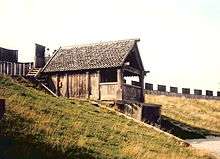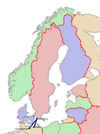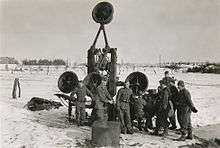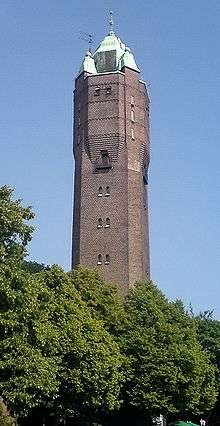Trelleborg
| Trelleborg | ||
|---|---|---|
|
Trelleborg town hall | ||
| ||
 Trelleborg  Trelleborg | ||
| Coordinates: 55°22′N 13°10′E / 55.367°N 13.167°ECoordinates: 55°22′N 13°10′E / 55.367°N 13.167°E | ||
| Country | Sweden | |
| Province | Scania | |
| County | Skåne County | |
| Municipality | Trelleborg Municipality | |
| Area[1] | ||
| • Total | 13.66 km2 (5.27 sq mi) | |
| Population (31 December 2015)[1] | ||
| • Total | 43,359 | |
| • Density | 2,071/km2 (5,360/sq mi) | |
| Time zone | CET (UTC+1) | |
| • Summer (DST) | CEST (UTC+2) | |
Trelleborg is a locality and the seat of Trelleborg Municipality, Skåne County, Sweden, with 28,290 inhabitants in 2010.[1] It is the southernmost town in Sweden.
History

The earliest written record of Trelleborg is from 1257, when Trelleborg was presented as a wedding gift from the Danish royal family to the Swedish Prince Valdemar. It was soon reconquered by the Danes, and it belonged to Denmark until 1658, when Scania was lost to Sweden by the Treaty of Roskilde.
In medieval times, Trelleborg had an important part in herring fishing. At that time, this was conducted along the entire coast line of what is now Sweden, as the herring shoals were of such great numbers that fishermen were said to have been able to stand on the shore and land fish with nets. Trelleborg became an important merchant city as merchants from Germany came to trade herring. In 1619 following a devastating fire, the Danish King decided that one merchant city on the coast was sufficient and revoked Trelleborg's status as a merchant city in favour of Malmö.
Not until 1840 was Trelleborg allowed to become a merchant city, and not until 1867 did it regain its rights as a city of Sweden. Mostly this was thanks to the work of a few stubborn men, who had continuously been petitioning the Swedish Riksdag with these requests since 1658. The local government reform of 1971 made Trelleborg the seat of Trelleborg Municipality, covering both rural and urban areas.
Climate
Although Trelleborg do not have an official month to month weather station featured in SMHI's reports, its nearest weather stations in Falsterbo and Malmö both indicate an oceanic climate with warm and sometimes hot summers averaging in the low 20's most of the time and cool but generally not very cold winters with means at or just above freezing.
The name
The first written record of the name is from 1291, Threlæburgh. The name is found in many places in Scandinavia.[2] Borg means castle or stronghold and träl can mean thrall, but can also refer to the leaning poles on the outside of the medieval Viking stronghold. Remains of the original stronghold were excavated in 1988.
The name may also have originated from the stronghold that still remains in the center of the city. Strongholds like that have been found at several places around Scandinavia, mostly in the south of Sweden and Denmark, and are all called trelleborgs. The name is likely to have originated from that borg.
Lenin's visit
During the First World War (1914–18), and after the February Revolution in Russia 1917, did Germany's hope of a separate peace treaty with Russia rise. But the new Russian "temporary leader" Alexander Kerensky declined. Then Germany gave the Russian communist agitator Vladimir Lenin and his companions in Switzerland a safe-conduct through the German Empire, in the hope that Lenin and the communists would destabilise Russia so that hopefully peace could be achieved at the Eastern Front. In August 1917 did Lenin and his entourage arrive to Scania, on this historically important journey, through the train ferry line between Saßnitz (Germany) and Trelleborg (Scania in Sweden).[3]
Today

At the end of the 19th century, Trelleborg became an industrial town and the foundation of modern Trelleborg has largely been created by a few large companies; most notably Trelleborg Industries and the ferry company and business related to the seaport. Much of it has been the work of the influential businessman Johan Kock. Other important industries he established were Akzo Nobel Inks, Today called Flint Group Sweden, manufacturing printing inks (established as Gleitzman Industries in the 1890s), and DUX, who make beds. Later in the 1950s, Perstorp (Flooring) Industries was established in Trelleborg and it manufactures flooring boards and other plastic material. Trelleborg continues to be a working-class-oriented city and is politically a traditional stronghold for the Swedish Social Democratic Party. However, since the latest elections in 2006 the Social Democratic Party is in opposition in the municipality.
It is today often visited by people travelling from Sweden to Germany because of the ferries to Rostock, Sassnitz, and Lübeck - Travemünde in Germany. These ferries began sailing on May 1, 1897, with the Sassnitz line; the route to Travemünde was established in 1962, while the line to the former East German city Rostock was inaugurated after the fall of the Berlin Wall in 1989. The ferries carry both passengers on one-day journeys, cars with vacationing families, and heavy trucks on their way through Europe. In April 1917, Lenin arrived with the ferry from Sassnitz to Trelleborg on his way from exile back to Russia to lead the Revolution.
Today Trelleborg has the second largest seaport of Sweden, behind Gothenburg. Every year it transports more than 10 million metric tonnes of cargo.
Overlooking the harbour of Smygehuk near Trelleborg is a statue of a nude woman that was installed in 1930. Uma Thurman's grandmother, the mother of Nena von Schlebrügge, was the model for this statue.[4] The entrance road from west has a row of palm trees, illustrating the southern location of the city. They are moved indoors during winter as they can't tolerate freezing temperatures.
Sports
The Trelleborgs FF, IFK Trelleborg, and FC Trelleborg football teams are based in the town.
Its basketball team is Trelleborg Basket.
Gallery
20th century
 Map of Trelleborg dated 1930
Map of Trelleborg dated 1930 Acoustic air-plane locator stationed in Trelleborg during World War II
Acoustic air-plane locator stationed in Trelleborg during World War II
21st century
 Part of Trelleborg harbour
Part of Trelleborg harbour
- Church of St. Nicolai
 Trelleborg Museum
Trelleborg Museum
See also
References
- 1 2 3 "Tätorternas landareal, folkmängd och invånare per km2 2005 och 2010" (in Swedish). Statistics Sweden. 14 December 2011. Archived from the original on 10 January 2012. Retrieved 10 January 2012.
- ↑ Svenskt ortnamnslexikon 2003
- ↑ Fischer 1964, p. 110–113; Rice 1990, pp. 140–144; Pipes 1990, pp. 391–392; Service 2000, pp. 257–260.
- ↑ Uma Thurmans mormor staty i Trelleborg, Sydsvenskan, 30 July 2006.(Swedish)
External links
![]() Media related to Trelleborg at Wikimedia Commons
Media related to Trelleborg at Wikimedia Commons
